Abstract
Global Climate change (CC) is featured by long-term changes in the mean values of climatic parameters (predominantly mean temperature) and in the profile of extreme weather events (e.g., increase in frequency, intensity, lengthening, and persistence). These climatic changes are supposed to have a deterioration impact on forest fire and flood disasters. Greece, an east Mediterranean country, is featured by a wide variety of micro-climates due to its unique geographical diversity, including hot and dry summers in the eastern part of the country (where a large amount of precipitation falls in the form of showers and thunderstorms) and wet winters in the western part. The combination of certain climatic zones with unfavorable land use and land cover changing patterns has resulted in several regions being prone to flooding and forest fires. The authors, based on relevant records, consider central and south Greece as flood and forest fire hotspots and attempt to: (a) present scientific estimations of local climate changes; (b) outline recent trends in the number of respective disasters and the amount of losses in these regions; (c) address recent changes in local climatic factors that might have influenced flood and forest fire hazard and risk in these regions; and (d) study the perceptions of the lay public and management authorities regarding the accountability of CC for flood and forest fire risk and hazard changes. The results show the variability of climate changes between neighboring areas, which directly affect the risk of forest fires and floods. Especially since the beginning of the 21st century, central Greece has been experiencing dramatic increases in both risks, while in south Greece the latter remain relatively stable. With regard to the perceptions of citizens and management authorities, the mental connection of local CC with forest fires and floods is still weak if not totally missing. Since knowledge and perceptions of the local “history” of forest fires and floods and the interconnections with CC by region is very important for the local communities to take appropriate mitigation and adaptation measures, this paper outlines a methodological path for similar studies to be conducted also in other regions of the Mediterranean basin and beyond.
1. Introduction
Climate change (CC) has become one of the most common interdisciplinary research topics in recent years. As has been documented, global warming, particularly since the mid-20th century, is due to anthropogenic causes, e.g., deforestation, burning of fossil fuels, land use change, etc. [1,2], in addition to natural factors such as the El Niño and La Niña phenomena, volcanic activity, solar activity, etc. [3,4]. Studies have shown that, along with the rise in the Earth’s average temperature, particularly since 1960, significant increases in both the number and intensity of extreme weather events and natural disasters have also occurred [5,6,7]. In the last ten years, 80–90% of all disasters recorded worldwide were due to floods, forest fires, droughts, extreme rainfall, and heat waves [8]. The Mediterranean region is considered a CC hotspot [9]. In the last two decades, both air and sea water temperatures have risen rapidly in the Mediterranean basin [10]. By 2018, the region’s average annual temperature was 1.4 °C higher than in 1880–1899, and 0.4 °C higher than current global warming trends [11]. Since 2000, extreme temperatures have been recorded more frequently; in many cases, these occur as heat waves [12] and cause a decrease in rainfall and an increase in droughts, forest fires, and secondary hazards [5,13,14]. In addition to heat waves, extreme rainfall is one of the most frequent extreme weather events, often leading to floods, landslides, etc., and poses a serious risk to people’s lives, agriculture, livestock farming, and urban infrastructure [15,16,17]. The Mediterranean Sea is a source of water vapor mainly in its coastal areas [18,19], making them particularly prone to extreme rainfall and flooding [19]. Due to the morphology of the Mediterranean basin (i.e., with many small and steep river basins, large mountain ranges, etc.), extreme rainfall in the region can easily turn into intense flooding events [19]. Ridges that stretch over hundreds of kilometers play an anticyclonic role, leading to extreme rainfall, particularly during the winter season [20]. Drought, in turn, is an extreme meteorological–hydrological event [21] and is described as one of the most important natural disasters which may contribute to the increase and intensity of forest fires [7,22]. In recent decades, the frequency and severity of drought events in the Mediterranean have increased significantly, particularly since the end of the 20th century, due to the rise in global temperatures combined with regional heat waves and the decrease in rainfall [23].
Overall, CC is directly linked to extreme weather events, as rising temperatures combined with reduced rainfall increase the number and intensity of extreme precipitation and droughts, which in turn affect the number and intensity of flood events and forest fires, as illustrated in the following sections. The present work focuses on the eastern Mediterranean and especially central and south Greece as a hotspot for the cause–effect relationships between CC and the increase in flood and forest fire disasters.
However, CC and its effects are not obvious to people as it is difficult to have personal experience with the cause–effect relationship between CC and disasters related to extreme meteorological/climatic phenomena. Understanding how individuals perceive these disaster risks is of particular importance. In recent years, a number of studies have been conducted with a focus on the perception of CC hazards and risks. Nevertheless, there are no studies juxtaposing and cross-examining scientific theoretical scenarios, empirical trends regarding the relationship between CC and flood and forest fire risk and the respective public perceptions.
Based on the above, some critical questions arise: (a) What has been the actual recent impact of CC on the historically exposed forest fire and flood hazard regions of central and south Greece? (b) What are the predictions for the future? (c) What are the public’s and management authorities’ perceptions regarding the role of CC in flooding and forest fire trends?
2. Materials and Methods
2.1. Scope and Objectives
The basic objective of this work is to offer evidence of the impact of the Mediterranean-region CC on forest fire and flood hazard (and risk) through the lens of scientific assumptions and predictions and analysis of historical empirical data, and to address relevant public perceptions. This is considered an issue of importance for the ecological, social, and economic sustainability of the hotspot regions for floods and forest fires. The regions of central and south Greece were selected for an illustrative example.
Continental Greece, in the eastern Mediterranean region, belongs to the hotspot sub-regions due to its geographical location and its complex and rare geomorphological features that result in different climatic zones within a few tens of kilometers [24]. The present study focuses on: (a) the objective/scientific risk, i.e., if there are indications of CC already affecting forest fire and flood hazard in central and south Greece and scientific predictions and estimations that it will continue to affect these areas further in the future; and (b) the subjective risk, i.e., public perceptions regarding the effects of CC on these risks, including the perceptions of the management authorities responsible. Central Greece (Attica, Sterea Ellada, Dytiki Ellada NUTS II Regions, Figure 1) and south Greece (Peloponnese NUTS II Region, Figure 1), with their rich history in terms of forest fire and flood disaster events in the last three decades, represent hotspot regions of the wider country’s territory. Central Greece (including Attica, Sterea Ellada, and Dytiki Ellada NUTS II Regions) is characterized by sizeable mountain volumes, with many plains, lakes, wetlands, and rivers. The climate is Mediterranean with dry summers and cold winters, as well as heavy rainfall mainly in mountainous areas [25]. South Greece (the Peloponnese NUTS II Region) is mainly mountainous, semi-mountainous, and steep, and has several plains, valleys, rivers, and catchments. Its climate is characteristically Mediterranean, with prolonged dry summers and mild rainy winters. In mountainous areas, winter is characterized by heavy rainfall [26]. Despite its proximity with central Greece and some physical geography commonalities, CC projections vary between the two regions. The region of central Greece accommodates the capital of Greece, Athens, in the east, and the city of Patras in the west. This is a major human geography difference (and is beside a land use and land cover difference) between the two regions affecting the predominant types of floods in each one (flash floods and river floods in central Greece, coastal and river floods in south Greece). It also affects the flood hazard to some degree and especially the loss potential (flood risk). On the other hand, forest fire risk (the potential for losses out of forest fire events) is also affected, but the forest fire hazard remains a factor mostly dependent on climate and meteorological variables. Therefore, this article basically deals with the hazards (as basic determinants of risk) and the variables of the disaster history that are configured basically by forest fire and flood hazard (the number of events in both cases and the areal size of the burnt areas, though the latter also depends on the suppression mechanism).
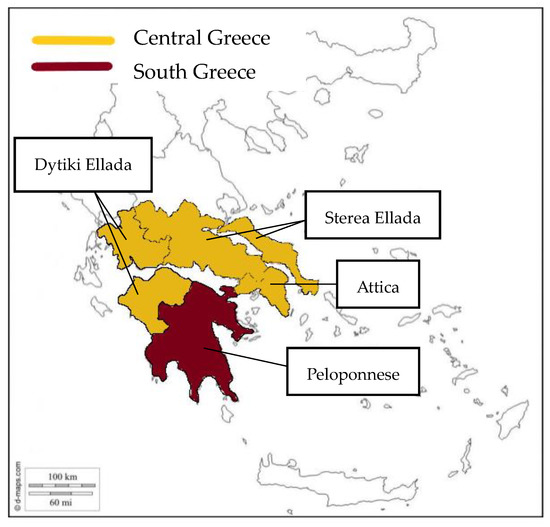
Figure 1.
Map of central and south Greece and NUTS II regions. Source: Authors’ elaboration.
2.2. Research Methods
The paper methodology is based on: (1) theoretical scientific assumptions; (2) empirical data for meteorological/climatic parameters; (3) time-series statistical analysis of flood and forest fire events in central and south Greece in the last three decades (1990–2020); and (4) structured questionnaires administered to a sample of the general public and key informers in central and south Greece.
The first analysis (1) relies on IPCC theoretical scientific assumptions regarding climate forecasts in central and south Greece. The second (2) is basically a descriptive statistic analysis using measures of central tendency—mean and maximum values in particular—of the climatic/meteorological variables that are crucial for the forest fire and flood hazard. The analysis focuses on the evolution of these values through consecutive time periods, each spanning 30 years. Indeed, thirty consecutive years are defined by the World Meteorological Organization as a normal climatic period to allow certain climatic elements to be representative of the climate of a region. The respective data sources have been the long-term climate series derived from the historical records of the World Bank Group, the World Data Info, and the National Oceanic and Atmospheric Administration. The aforementioned data refers to the average monthly maximum temperature in central and south Greece and the average monthly rainfall for the periods 1961–1990 and 1991–2020 and also to the average maximum rainfall for the period 1990–2020. Only as a mere indication of the long-term changes in humidity, the data for the average monthly humidity in the study areas for the periods 1955–2010 and 2000–2020 were also included (despite the incomparability of the time spans). The third (3) is a univariate (statistical) analysis of the numbers of floods and forest fire events (and burnt areas as well) describing their yearly and monthly distribution over the 30-year period of 1990–2020. The number of recorded events and the areal size of the burnt areas (in the case of forest fires) were considered directly dependent on the respective hazard levels, determined basically by meteorological/climatic parameters. The data used were collected from a set of sources including scientific articles, official sites of national meteorological organizations, and governmental agency reports [27,28,29,30,31]. The fourth survey (4) is about structured questionnaires targeting the perceptions of the participants on the impact of CC on floods and forest fires in their place of residence. These were administered to samples of the general public and key informers in central and south Greece. Cross-examination of the results of these analyses featured convergences and divergences amongst and between facts, predictions, and perceptions. However, subjective risks are as important as objective risks for the adoption of mitigation and adaptation policies to address CC and its impact on flood and forest fire risk.
The questionnaire survey addressed to the general public was based on a web-based sampling of 317 inhabitants, of which 99 were residents of the NUTS II Region of Sterea Ellada, 84 residents of Attica, 51 residents of Dytiki Ellada, and 83 residents of the NUTS II Region of Peloponnese (the south Greece region). Moreover, 52.05% of the respondents were men, 57.73% were aged 18–35 years (since the questionnaire was shared through social media and e-mail due to COVID-19), 24.29% were aged 36–59 years, and 17.98% were aged 60+ years. In addition, 46.06% had achieved a tertiary education (with 17.67% holding a master’s/doctoral degree), 29.34% had completed secondary education, and only 6.94% had the compulsory education.
The questionnaire addressed to key informers involved 42 employees of management authorities (administrative regions, fire corps, and forest authorities), of whom 64.29% belonged to central Greece and 35.71% to south Greece. In addition, 66.67% of them held a tertiary education degree, and 33.33% had a master’s/doctoral degree. The survey was followed by a univariate analysis of the variable “perception of the accountability of CC for forest fire and flood hazard changes” and the distribution of positive and negative responses to age groups.
3. Results
3.1. Forest Fire Hazard and Risk: Definitions and Determinant Factors
Risk has many different meanings due to its multidisciplinary features and subjectivity in its conceptualization and perception [32]. Events that can have unpleasant effects on both humans and the environment occur on a daily basis and represent everyday risks. The term “risk” allows us to describe anything that may have adverse consequences for humans, and hence a possible loss of value [33,34].
Most of the traditional definitions of forest fire or wildfire risk only refer to wildfire likelihood and behavior, and do not consider the expected impacts of fire [35]. However, UNISDR identified this problem and redefined wildfire risk as “the likelihood of a fire occurring, the associated fire behavior, and the impacts of the fire” [36]. Hence, risk mitigation is achieved when any of the three parameters (likelihood, behavior, and/or impacts) is reduced. Wildfire risk assessment is based on statistical studies of previous patterns of forest fire start and behavior. The forest fire risk increased in the Mediterranean region, particularly during the 20th century, due to various socio-economic and climatic changes [36,37].
Whereas the majority of forest fires around the world occur due to anthropogenic causes, the existence of heat sources alone is insufficient for the start of a forest fire [38]. The topography, weather conditions, humidity of vegetation, and moisture of the fuel play an equally important role [39,40]. The topographical formation, slope, and altitude of an area can significantly affect the propagation and behavior of forest fires [39,40,41,42] and weather conditions (air temperature, relative humidity, rainfall, and wind) have a significant impact on fire behavior while affecting the size of the burnt areas [43,44], and the fuel significantly influences the behavior of fires [40,42,43,44,45,46,47,48].
The present work focuses on forest fire hazard, i.e., the likelihood of a fire occurring and the associated fire behavior. Forest fire hazard is one of the determinants of forest fire risk, the other being the vulnerability of the exposed elements (vegetation, buildings, technical infrastructure, etc.). Since the prevailing meteorological and climatic conditions, i.e., the major determinants of forest fire hazard in a region, are affected by CC, it is reasonably expected that the ignition and spread of forest fires, as well as their size and behavior, will also be affected. The respective suggestions in the literature were investigated and they are presented in the following paragraph.
3.2. Trends of Forest Fire Hazard/Risk in Greece under the CC Perspective: Bibliographical Suggestions
Rising air temperatures and ongoing drought conditions in recent years, combined with extreme weather events, land use change, and the lack of rainfall, favor a higher frequency and intensity of fires [44,49,50,51]. Notable changes include the reduction in the time intervals between successive fires and the extension of the fire season (which officially extends from May to October in Greece) [52,53,54,55,56].
Although it is practically impossible to provide accurate forecasts of the increases in the frequency and intensity of forest fires due to CC in a particular area, it is possible to identify the ongoing effects of CC on forest fire hazard (and hence risk) determinants (air temperature, relative humidity, rainfall, and average wind speed) and thus outline the new pattern of forest fires [56,57].
According to a study by the National Observatory of Athens, which was presented on the Oikoskopio website under the title “Climate change and forest fires”, CC is expected to significantly impact the climate map of Greece by the end of the 21st century, significantly increasing the number of days of heat waves and therefore the threat of forest fires, where the areas of central and south Greece will be the most affected [58].
3.3. Flood Hazard and Risk: Definitions and Determinant Factors
Flooding is the second most frequent natural disaster after forest fires in the eastern Mediterranean and are due to both human activities and technological accidents as well as weather and meteorological factors, such as heavy rainfall inducing river overflow, hurricanes and strong winds in coastal areas, dam breaks, and melting ice and snow [59,60,61,62,63,64,65,66,67].
Floods, as hazards, are socio-natural phenomena, in the sense that human interventions, building development and land use, and land cover changes (e.g., deforestation and filling up ponds) intensify flood hazards. The risk of flooding is a combination of the probabilities of occurrence and the negative consequences of flood on both people and the environment in a given area [61,63].
The present work basically deals with flood hazard (not risk) and more in particular with the natural triggering factors of the flood hazard (primary and secondary), e.g., extreme precipitation. The degree of hazard varies with the severity of flooding and is affected by flood behavior (extent, depth, velocity, isolation, rate of rise of floodwaters, duration) and topography. Flood intensity usually refers to the combination of flood depth and horizontal flood extent, although other intensity measures such as flow velocity and flood duration can also be important depending on the situation [67,68]. Flood risk is dependent on the existence of a source of flooding, such as a river, a route for the flood water to take (pathway), and something that is affected by the flood (receptor), such as a housing estate, and “this event has a probability of occurrence within a specified period of time and within a given area, and a given intensity” [69].
3.4. Trends in Flood Risk in Greece from the CC Perspective: Bibliographical Suggestions
A warmer atmosphere can hold up to 10% more water vapor [70,71], resulting in increases in the number and intensity of extreme rainfall events [72]. However, the link of CC to floods continues to be difficult to address. Although a theoretical link exists between them, no clear evidence of their relationship has been published because recorded flood data are limited [73,74]. Therefore, scientists are reluctant to attribute accountability for the floods to CC as it is impossible to determine whether an event would have occurred if the climate had not changed [69]. Floods in central and south Greece are associated with natural causes, including the rate and amount of water collected during a rainfall, intensity of the rainfall, soil surface conditions, etc., probably in combination with the destruction of forests (located upstream) due to fires [75].
Despite the missing statistical evidence, several bibliographical sources point to the key role played by CC in the occurrence of floods. Is this suggestion valid in the case of central and south Greece? What are the indications from the correlation of the recent history of flood events with regional CC (in the last thirty years and more)? The next section deals with these issues.
3.5. History of Forest Fire and Flood Events in Central and South Greece, 1990–2019: Possible Correlations with Regional CC
3.5.1. Future Scenarios and Attested Climatic Changes for Central and South Greece
According to the RCP4.5 scenario (moderate scenario), an increase of 0.97–1.5 °C in the mean annual maximum temperature is projected for the period 2031–2050 in central Greece (compared to the 1981–2000 period) and an increase of 1.82–2.6 °C for the 2081–2100 period. The RCP8.5 scenario (worst scenario) refers to an increase of 1.23–2.1 °C in the period of 2031–2050 and 3.92–4.7 °C in the period 2081–2100 [76,77,78]. Additionally, due to CC, hot days (days with the temperature exceeding 30 °C) are expected to increase in the region. In the IPCC’s A1B scenario (the older moderate scenario), it is estimated that, by the end of the 21st century, the annual number of hot days will significantly increase compared to 1961–1990. In central Greece, this increase has been estimated to reach 21–25 days in 2021–2050 and 28–48 days in 2071–2100 [57].
Extreme rainfall is expected to increase by 30% by the end of the 21st century, significantly increasing the likelihood of floods and landslides [56]. However, regarding annual rainfall rates in central Greece, according to the RCP4.5 emissions scenario, it is estimated that rainfall will reduce by 4–6% in 2031–2050 (compared to the period 1981–2000) and by an additional 3–6% in 2081–2100. According to the extreme scenario (RCP8.5), the reduction will be 3–6% in the near future and about 15% in the distant future [76,77,78]. Drought days (the number of days with the total daily rainfall below 0.5 mm) are also expected to increase by 40 on an annual basis until the end of the 21st century, negatively affecting forest fuel and the moisture content of forest vegetation in central Greece [56,57].
Regarding south Greece, the RCP4.5 emission scenario estimates that the temperature will increase by 1.7 °C in 2031–2060 and 2.2 °C in 2071–2100. According to the extreme scenario (RCP8.5), the temperature is expected to increase by 2 °C in 2031–2060 and 4.3 °C in 2071–2100 [26]. The IPCC’s A1B emissions scenario estimates that hot days will increase annually by 23 in 2021–2050 (compared to 1960–1990) and 39 in 2071–2100 [56]. With regard to annual rainfall rates, a decrease of 5–12% is estimated by the RCP4.5 scenario and 5–20% by the RCP8.5 for 2031–2060 (compared to 1971–2000). For the period 2071–2100, RCP4.5 predicts reductions of 10–20%, whereas the RCP8.5 scenario predicts reductions of 15–30% [26]. This will result in an increase in periods of prolonged drought, making the area prone and vulnerable to forest fires, landslides, and floods due to the occurrence of extreme rainfall events and rising sea levels. The prolonged meteorological droughts will worsen the risk parameters of forest fires, such as relative air humidity, soil moisture, and vegetation water content [56].
Figure 2 illustrates the average monthly temperature and rainfall for the periods 1961–1990 and 1991–2020 based on data from meteorological stations in central and south Greece.
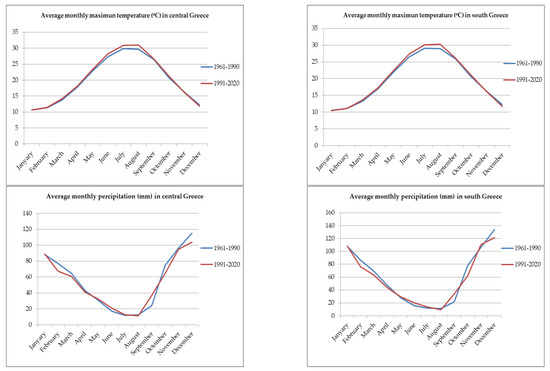
Figure 2.
Average monthly maximum temperature (°C) and average monthly precipitation (mm) in central and south Greece (1961–1990) and (1991–2020). Source: Authors’ elaboration based on data by the World Bank Group [79].
According to Figure 2, the average monthly temperature in central Greece in 1991–2020 was higher than in 1961–1990 all year round, except for the winter season, whereas in south Greece, the temperature was higher from March to August.
Regarding the average monthly rainfall, central Greece presented lower rates in the 1991–2020 period compared to 1961–1990 almost all year round except for the months of May, June, July, and September, but also south Greece showed approximately the same decrease. As shown in Figure 3, central Greece presented a lower average monthly humidity throughout the year in 2000–2020 compared to previous periods. However, this was not the case with south Greece, where the levels of humidity were higher in 2000–2020 (compared to 1955–2010), especially during the spring and summer months.
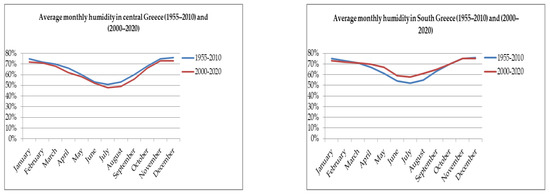
Figure 3.
Average monthly humidity (%) in central and south Greece (1955–2010) and (2000–2020). Source: Authors’ elaboration based on published data [79,80].
According to the following (Figure 4 and Figure 5) and considering the period of 1990–2020, it seems that the extreme rain intensity events per month (those exceeding 124 mm) occurred more frequently from 2010 onwards in the case of central Greece. However, in south Greece, extreme rain events were more frequent before 2004.
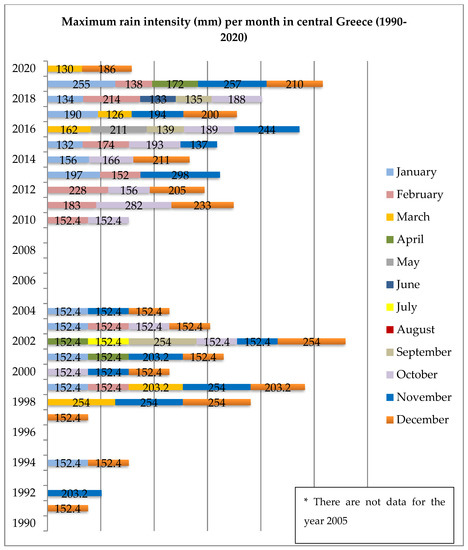
Figure 4.
Maximum rain intensity events per month in central Greece (1990–2020). Source: Authors’ elaboration based on published data [81].
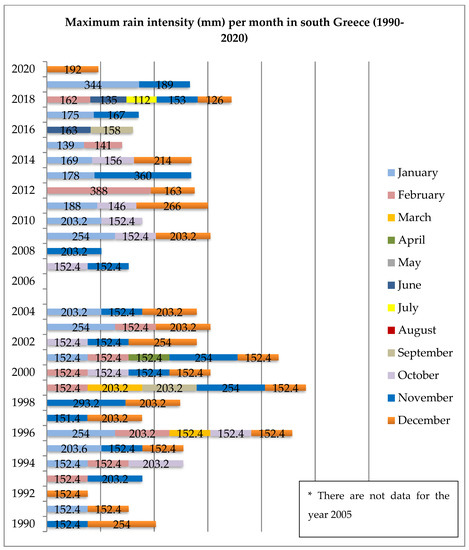
Figure 5.
Maximum rain intensity (mm) per month in south Greece (1990–2020). Source: Authors’ elaboration based on published data [81].
3.5.2. History of Forest Fire Events in Central and South Greece, 1990–2019: Correlations with Past and Future Regional CC
Forest fires are a fairly common phenomenon in Greece and are directly related to the prevailing meteorological conditions, land cover patterns, land use conflicts and changes [82]. The areas burnt in Greece during 1991–2020 amounted to 13,009,032 acres, of which 51.83% was located in central and south Greece [83,84]. Burnt areas are an indicator of the size of the fire and hence fire behavior, which is directly connected to meteorological and climatic parameters and the forest fire hazard. Figure 6 depicts the burnt areas in central and south Greece in 1991–2004 and 2005–2020.
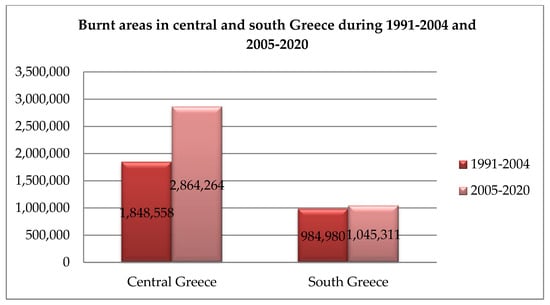
Figure 6.
Burnt areas (in acres) in central and south Greece in 1991–2004 and 2005–2020. Source: Authors’ elaboration based on published data [28,83,84].
Figure 6 shows that while there were no particular changes between the two periods in south Greece, the burnt areas increased by almost 1,000,000 acres (50%) in the period 2005–2020 in central Greece. Figure 7 shows the number of fires in central and south Greece during the periods 1991–2004 and 2005–2020.
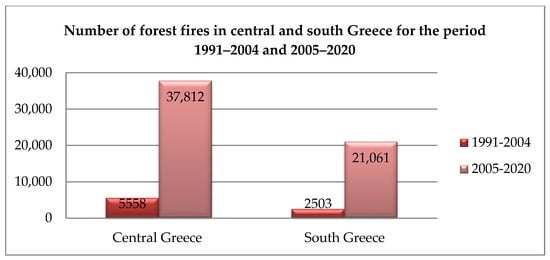
Figure 7.
Number of forest fires in central and south Greece for the periods 1991–2004 and 2005–2020. Source: Authors’ elaboration based on published data [28,83,84].
Figure 8 shows that except for the radical increase in the number of events, their annual distribution across the country changed substantially from 1991–2004 to 2005–2019.
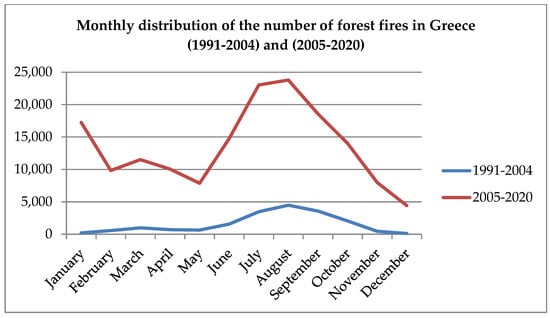
Figure 8.
Monthly distribution of the number of forest fires in Greece (1991–2004) and (2005–2020). Source: Authors’ elaboration based on published data [28,83,84].
After 2005, the forest fire period tended to cover the whole year, as fire season extended to include even the spring and winter months: January, February, March, April, November, and December (with almost zero events in the preceding period).
All in all, it seems that the history of forest fire events, in terms of numbers, areal size, and annual distribution as indicators of forest fire hazard (fire start and behavior) follow the increasing trends of the respective critical climatic parameters as confirmed empirically. Should scientific scenarios for the future be confirmed, this increasing trend will continue and intensify at that. However, the degree of increase in the forest fire hazard (and the underlying critical climatic changes) vary from one region to another.
3.5.3. History of Flood Events in Central and South Greece, 1990–2019: Correlations with Past and Future Regional CC
In accordance with Directive 2007/60/EC concerning the “assessment and management of flood risks”, Greece has designated Areas of Potential Significant Flood Risk (APSFR) based on data for significant historical floods, the identification of areas where flooding is likely to occur, and areas where future floods will have potentially significant consequences [29].
In 1991–2020, 570 severe flood events were recorded in central and south Greece, of which 423 occurred in central Greece and 147 in southern Greece. All of them were associated with extreme precipitation [30,31,85,86].
The two regions were hotspots due to urban and river floods originating mostly from extreme weather events combined with a lack of appropriate drainage infrastructure, riparian building development, and riverbed filling or narrowing [31]. The number of floods manifested in an area and a time period is a major flood hazard indicator directly connected with extreme precipitation, especially if the topographical, land cover, and drainage infrastructure parameters remain unchangeable. Figure 9 and Figure 10 show the number of floods in central and south Greece for the period 1991–2020. Remarkably, after 2000, especially in central Greece, there have been no years without flooding events.
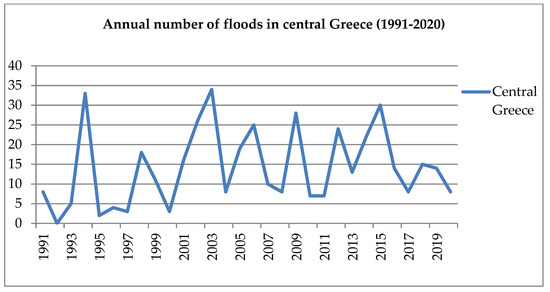
Figure 9.
Annual number of floods in central Greece (1991–2020). Source: Authors’ elaboration on the basis of published data [31].
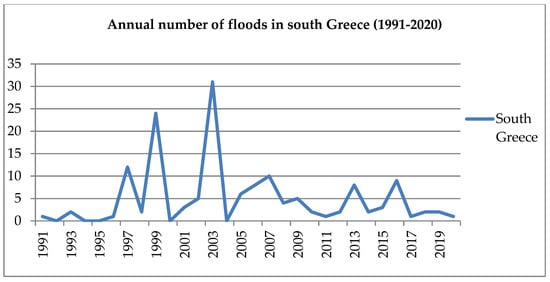
Figure 10.
Annual number of floods in south Greece (1991–2020). Source: Authors’ elaboration on the basis of published data [31].
From 2003 onward, the annual number of floods in central Greece has been increasing constantly, while this trend was been confirmed in south Greece. It should be pointed out that most of the flood events in central Greece were either river or urban flood cases located in the metropolitan areas of Athens and Patras or minor urban settlements, while all those in south Greece were river or coastal floods (probably intensified by former forest fires) as the region lacks major urban settlements. It is obvious then that the territorial and infrastructure changes, which may directly affect the possibility for a flood after an extreme rainfall event, occurs more often and is more likely to occur in urban areas than in rural areas. According to Figure 11, showing the monthly distribution of flood events in central Greece, flood events in 1991–2004 tended to occur mostly in three months: November, October, and January. However, in the following period (2005–2020), flooding increased significantly throughout the year and covered not only winter but also autumn months.
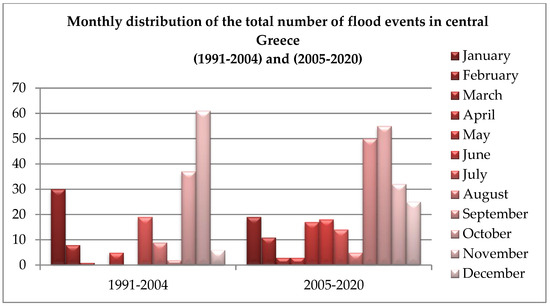
Figure 11.
Monthly distribution of the total number of flood events in central Greece (1991–2004) and (2005–2020). Source: Authors’ elaboration on the basis of published data [31,86].
In south Greece (Figure 12), most of the floods occurring in 1991–2004 were recorded in January and November, while in 2005–2020, flood events were recorded throughout the autumn and winter seasons. Furthermore, floods began to also occur during the spring and summer.

Figure 12.
Monthly distribution of the total number of flood events in south Greece (1991–2004) and (2005–2020). Source: Authors’ elaboration on the basis of published data [31,86].
Figure 13 focuses on Attica (a sub-region in central Greece accommodating metropolitan Athens) with regard to the mean maximum intensity of rainfall events per month in three successive periods: 2010–2012, 2013–2015, and 2016–2019. The figure indicates an upward trend in the maximum rain intensity for almost all months (with peaks in February, June, and November).
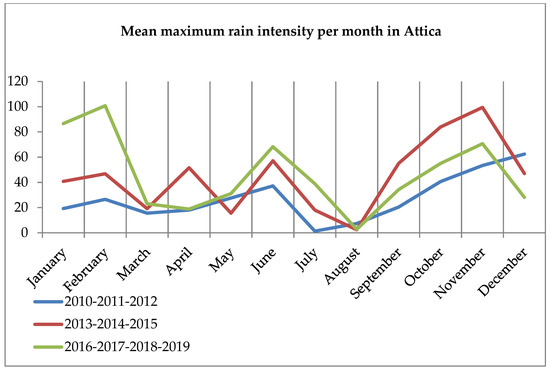
Figure 13.
Mean maximum rain intensity (mm) per month in Attica in the periods of 2010–2012, 2013–2015, and 2016–2019. Source: Author’s elaboration on the basis of published data [87].
In Section 3.6, the perceptions of the citizens and management authorities of central and south Greece are presented regarding the effect of CC on floods and forest fires. Additionally presented are the survey participants’ observations regarding changes in climate and the pattern of meteorological and climatic disasters in their place of residence.
3.6. The Public Perception of Citizens and Management Authorities on the Accountability of CC for Increasing Flood and Forest Fire Risk
The perceptions of individuals and management authorities play a key role in addressing CC challenges, either through adaptation or mitigation strategies. However, appropriate communication strategies to improve perceptions necessitate addressing current perceptions of people and responsible authorities on CC and its impact on meteorological and climatic disasters.
The analysis of the results of the questionnaire survey indicated that both citizens and the management authorities of central and south Greece believe in the reality of CC (Figure 14). In addition, both the staff of management authorities and citizens in central and south Greece are ambivalent regarding the causes of CC. Half of them hold that CC is due to human-induced causes only while half believe that it is due to both natural and manmade causes (Figure 15).
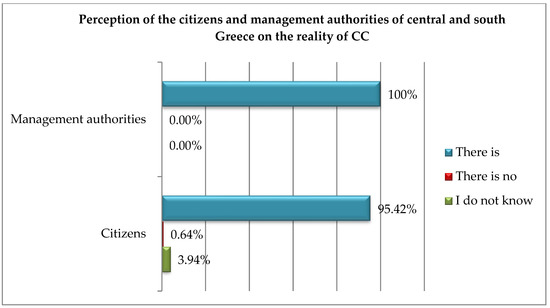
Figure 14.
Perception of the citizens and management authorities of central and south Greece on the reality of climate change.
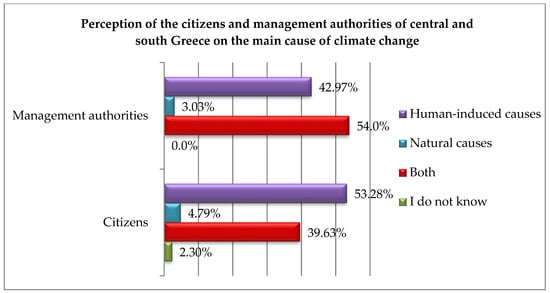
Figure 15.
Perception of the citizens and management authorities of central and south Greece with regard to the main cause of climate change.
The following Figure 16 and Figure 17 indicate the results of the survey regarding participants’ observations of changes in climatic parameters and their living and working environment. According to Figure 16, 52% of the management authorities in central Greece observed warmer winters in the region in the last fifteen years (compared to 1991–2004), 48% observed more extreme rainfall, 44.44% more storms and stronger winds but also warmer summers, and 40.74% noticed changes in flowering times and plant growth. Regarding the citizens of central Greece, 59.40% observed warmer winters in the region, 58.12% more heat waves, 51.28% warmer summers, and 41.45% more extreme rainfall.
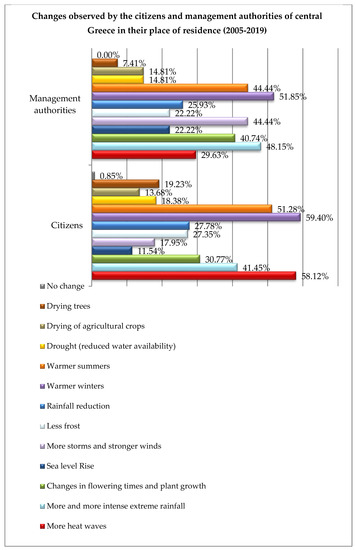
Figure 16.
Changes observed by the citizens and management authorities of central Greece in their place of residence (2005–2019).
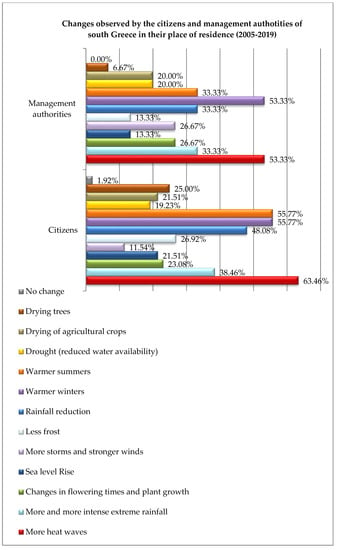
Figure 17.
Changes observed by the citizens and management authorities of south Greece in their place of residence (2005–2019).
Accordingly, 53.33% of the surveyed management authorities in south Greece observed more heat waves and warmer winters in the region (2005–2019) (Figure 17). In addition, 33.33% noticed trees drying, reduced rainfall, and increased extreme rainfall. Regarding citizens, 63.46% observed more heat waves in the region (over the same period), 55.77% warmer winters and summers, 48.08% a decrease in rainfall, and 38.46% noticed more extreme rainfalls.
Figure 16 and Figure 17 show that the most notable changes in both regions by both the management staff and the citizens were warmer summers and warmer winters, more heat waves, and more intense extreme rainfalls.
Figure 18 and Figure 19 below show that over 50% of management authorities and citizens both in central and south Greece had not noticed any increase in forest fires or floods in their region in the last 15 years. However, the portions of the respondents who noticed an increase are significant (about 40%).
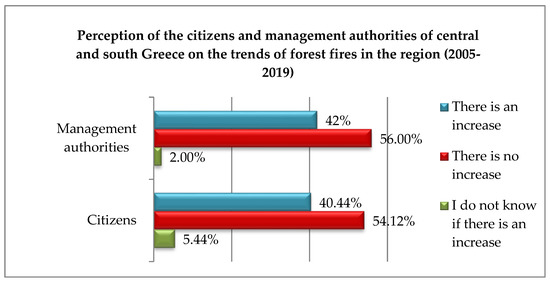
Figure 18.
Perceptions of the citizens and management authorities of central and south Greece on the trends of forest fires in the region (2005–2019).
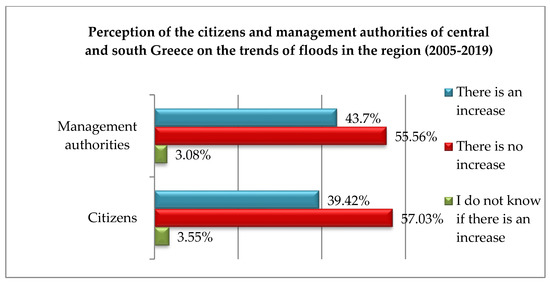
Figure 19.
Perceptions of the citizens and management authorities of central and south Greece regarding the trends in the number of floods in the region (2005–2019).
Considering the age groups of the respondents in central and south Greece, it seems that most of the responders who noticed an increase in forest fires belonged to the age groups 18–35 and 60+ (Figure 20). However, before 15 years, the first group was passing the childhood or adolescence period and the attention of the group members to forest fires at that age could not be but low. On the other hand, the perceptions of the aged (60+) account for longer life spans that allow for the detection of differences in forest fire risk in the last 30 years. It may be the case that the youngest group “consider” an increase in forest fires not only because of their high education attainment levels (see the education features of the sample, p. 4) speaking for better access of the youngsters to environmental information, but also because of their relatively recent school education background including CC issues. On the other hand, the aged may “view” an increase in forest fire risk out of empirical observation.
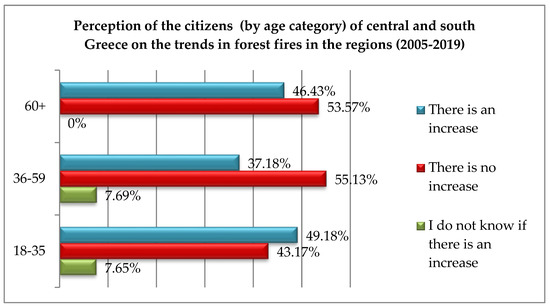
Figure 20.
Perceptions of the citizens (by age category) of central and south Greece on the trends in forest fires in the region (2005–2019).
Notable are the low portions of respondents (less than 40%) of all age groups who noticed an increase in floods in the last 15 years (compared to the period 1990–2004) (Figure 21).
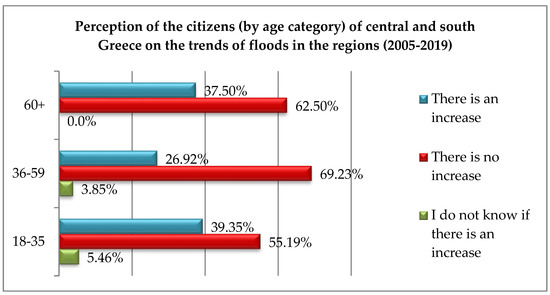
Figure 21.
Perceptions of the citizens (by age category) of central and south Greece on the trends of floods in the regions (2005–2019).
However, as shown in the following Figure 22 and Figure 23, over 79% of the citizens and management authorities in central and south Greece believed that CC can contribute to increases in forest fires and floods. This contradiction indicates that a large portion of the responders do believe in the occurrence of CC but not in its local effect on forest fires and floods.
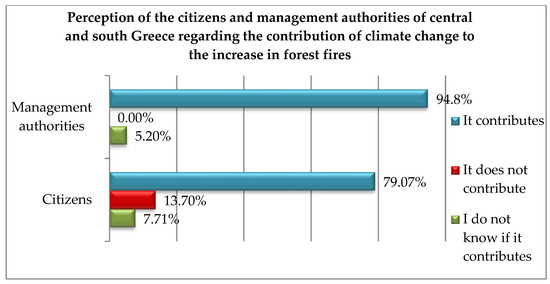
Figure 22.
Perceptions of the citizens and management authorities of central and south Greece regarding the contribution of climate change to the increase in forest fires.
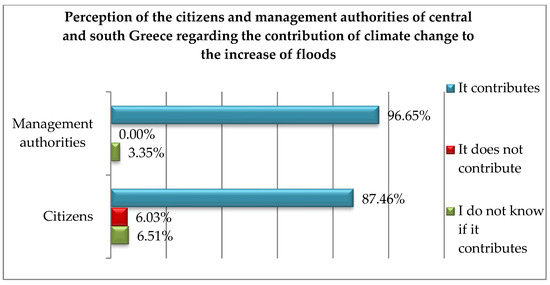
Figure 23.
Perceptions of the citizens and management authorities of central and south Greece regarding the contribution of climate change to the increase in floods.
According to Figure 24 and Figure 25, the vast majority (over 80%) of respondents belonging to the 18–35 and 36–59 age groups considered CC a major contributor to the increase in forest fire and flood risk. However, the 60+ age group was divided by the relatively high proportion of responders opposing the above thesis.
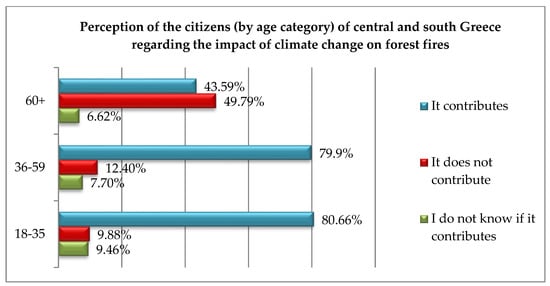
Figure 24.
Perceptions of the citizens (by age category) of central and south Greece regarding the contribution of climate change to the increase in forest fires.
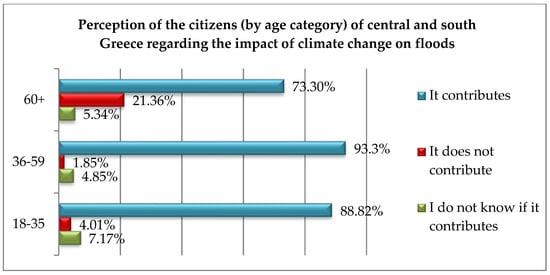
Figure 25.
Perceptions of the citizens (by age category) of central and south Greece regarding the contribution of climate change to the increase in floods.
4. Discussion
The basic focus of this study was the following query: how does CC contribute to the increase and change in the pattern of forest fires and floods in central and south Greece? The authors attempted to provide an answer through the lens of the scientific community’s assumptions, the empirical reality evidenced by forest fire and flood disaster history, and the perceived climatic and forest fire and flood risk changes by the general public and the staff of management authorities. The results of the cross-examined analyses showed that the history of forest fires and floods in central and south Greece in the period 1990–2020 is of particular scientific interest when related to the regional climatic changes in the period 1960–2020. Of special interest is also the juxtaposition of the objective with subjective risks, i.e., the perceptions of citizens (and management authorities) about CC and how it affects forest fires and floods, both theoretically and empirically in the region of their residence/responsibility.
Table 1 presents the theoretical assumptions about regional CC in central and south Greece as quoted in scientific research and its impact on forest fire and flood risk, and compares these assumptions with the trends appearing from the history of relevant disaster events in the regions of concern.

Table 1.
Comparison between the CC theoretical assumptions for central and south Greece, the actual trends in meteorological and climatic parameters of central and south Greece, and the historical trends in forest fire and flood events in these regions.
As observed in Table 1, in central and south Greece, the theoretical suggestions, the statistical trends in critical meteorological and climate parameters, and the evolution of forest fire and flood disaster events converge more or less with each other. This is more evident in the case of the forest fire hazard. The case of flood hazard is more complex as it differs between urban and rural areas and it is equally dependent on climatic and non-climatic factors.
The most important findings regarding the history of flood events and interconnections with regional CC in central and south Greece are: (a) continuous increase in the cumulative maximum rain intensity (per year) in central Greece, after 2010; (b) continuous increase in the maximum rain intensity per month in Attica in the decade 2010–2020; (c) a continuous upward trend in the annual number of flood events in central Greece (1991–2020); and (d) the extension of the flooding period from two winter months to almost the whole year. Since flood events are almost always associated with extreme weather events in these regions, the increasing trend of extreme rainfall events in central Greece and Attica in particular, is a precursor of an increase in future flood events in this region. These findings are analogous to those for forest fires and the forest fire period which after 2005 tended to cover the whole year, as the fire season extended to include even the spring and winter months: January, February, March, April, November, and December (with almost zero events in the preceding period). The once seasonal meteorological and climatic disasters are rapidly spreading throughout the year, and their occurrence should be expected year round.
Table 2 describes the views of the public and the management authorities of central and south Greece on CC being in progress and CC’s responsibility for changes in flood and forest fire hazard patterns in their region.

Table 2.
The views of the general public and management authorities of central and south Greece on the responsibility of CC for increases in flood and forest fire hazard/risk in their region.
According to Table 2, all of the staff of management authorities and almost all (over 95%) of the citizens surveyed believe in the reality of CC. At the same time, very high proportions of citizens (about 75–95%) and management authorities (reaching 100%) believe that CC has an increasing impact on flood and forest fire hazard/risk. Notably, more than half of them have not noticed/considered any increase in these risks in their region. To some extent, this is not surprising for flooding in south Greece, since increases in the number of events are barely detectable in the disaster history of the region. For the case of forest fires, however, especially in central Greece, the majority’s risk perceptions do not converge with the heightened objective risk, as evidenced by the disaster history of the region and the statistics of the critical climatic and meteorological parameters. This inconsistency and the underlying reasons represent a new research query deserving further research: what does it account to the people for the forest fire hazard/risk increase, incapacity of the suppression/pre-suppression mechanism, climatic changes or other reasons?
Both the citizens and management authorities in both regions tended to observe and acknowledge the primary climatic/meteorological changes, i.e., warmer winters, warmer summers, rainfall decrease, more heat waves, and more extreme rainfall. Secondary impacts and changes, such as the forest fire and flood risk changes, were less observed as effects of CC.
Of the respondents in central and south Greece who did not notice any increase in forest fires in their area in the last 15 years, the majority were aged 36–59 and 60+ years. On the contrary, of those who did notice increases in forest fires in central and south Greece, the majority were younger, aged 18–35 years. It seems that most of the replies to the query about observations of increases in forest fire hazard/risk were based on the beliefs, knowledge, and information of the respondents about the impact of CC on these risks rather than on actual observations. This may be due to the fact that in the last two decades, there has been an effort to include environmental education and CC issues in the curricula of the country’s schools. In addition, younger age highly educated groups have more at their disposal and more reliable information channels. However, the majority of respondents from all three age groups had not noticed an increase in flooding.
The perceptions of the citizens and the management authorities of central and south Greece were found not to be entirely in line with the events and future forecasts for CC, based on the scenarios RCP4.5 and RCP8.5. CC and its effects are not always clear to people as it is difficult to have personal experience with the cause–effect relationship between CC and extreme phenomena; additionally, culturally constructed beliefs can strongly influence people’s perceptions. These divergences are likely to affect the practical adoption of mitigation and adaptation measures. In addition, understanding how individuals perceive risk is of particular importance for risk education and risk communication [88,89].
Mitigation and adaptation depend of course on the public policies planned for CC. However, the contribution of citizens is of major importance. If mitigation and adaptation policies are put in place by the management authorities without the actual involvement of the citizens, the implementation of the planned policies is doubtful. Consequently, the involvement of citizens in the planning and implementation of mitigation and adaptation measures is a key factor to sustainability at all levels from local to global.
However, each region has its own CC profile and distinct effects on the local forest fire and flood hazard, meaning that each region should be studied and managed differently on the basis of its unique relationship between regional CC, the local history/trends of climatic, meteorological, and hydrological disasters, and the respective public risk perceptions.
5. Conclusions
The Mediterranean is one of the world regions most exposed and vulnerable to CC. This paper presented (a) the scientific assumptions about climate changes in the eastern Mediterranean; (b) the actual changes in the climatic and meteorological variables that have been critical for forest fire and flood risk in central and south Greece (hotspots for floods and forest fires in the eastern Mediterranean) in the last 30–60 years; (c) the forest fire and flood disaster history of these hotspot sub-regions; and (d) the perceptions and observations of local communities and risk management authorities as to the actual CC effect on local floods and forest fires. A cross-examination of the results of the above analyses sheds light on the climate changes actually occurring in these neighboring sub-regions, on the divergences from scientific models, on the transformed patterns of forest fire and flood hazard in time and space, and on the local communities’ and management authorities’ perceptions and prejudices.
Scientific prediction models of CC in central and south Greece (by 2100) indicated significant increases in air temperature, hot days, droughts and extreme rainfall, and floods and forest fires, as well as decreases in annual rainfall rates. Up-to-date empirical data showed slight spatial diversity in the changes occurring since the mid-20th century. While both central and south Greece follow the projections more or less, south Greece, however, was found to be in a slightly better situation in terms of average monthly maximum temperature, average monthly humidity, and extreme rainfall. Since the beginning of the 1990s, the history of forest fire and flood disaster events has followed actual climatic changes. Therefore, central Greece has experienced dramatic increases in forest fire and flood risk, while the respective risks in south Greece have remained relatively stable. It should not escape attention, however, that land cover and land use changes and anthropogenic pressures within and around metropolitan urban areas have also contributed to the faster escalation of the above hazards/risks in the case of central Greece.
Knowledge of local history of disaster events is critical for building public perceptions that are in line with real changes in forest fire and flood risk (objective risk). The observations and perceptions of the citizens and management authorities indicated that the mental connection of local CC with forest fire and flood risk changes is still weak or totally missing. Additionally, it seems that the socio-demographic characteristics of the responders, particularly their education level and age, affected their perceptions, most probably built on the basis of distinct partial knowledge and the information sources that they have access to. From this perspective, further research is needed on CC information sources and the channels of information dissemination that affect perceptions: the curricula of education institutions, the CC agenda in the mass media, and the role of social media.
Author Contributions
Conceptualization, D.A. and K.S.; methodology, D.A. and K.S.; formal analysis, D.A. and K.S.; investigation, D.A.; resources, D.A.; data curation, K.S.; writing—original draft preparation, D.A. and K.S.; writing—review and editing, D.A. and K.S.; visualization, D.A. and K.S.; supervision, K.S.; project administration, K.S.; funding acquisition, K.S. All authors have read and agreed to the published version of the manuscript.
Funding
This research was co-financed by Greece and the European Union (European Social Fund—ESF) through the Operational Programme «Human Resources Development, Education and Lifelong Learning» in the context of the project “Strengthening Human Resources Research Potential via Doctorate Research” (MIS-5000432), implemented by the State Scholarships Foundation (ΙΚΥ) and by Sapountzaki, K.
Institutional Review Board Statement
The Research Ethics Committee of Harokopio University, during the 36th Meeting of 27/01/2022, after examining the content of the Research Project with the title “Climate Change Affecting Forest Fire and Flood Risk—Facts, Predictions, and Perceptions in Central and South Greece”, decided unanimously and approved that the above Project could be implemented at the Department of Geography, Harokopio University. The Committee also approved the Voluntarily Participant Text, as it is attached to the proceedings of the above 36th Research Ethics Meeting.
Informed Consent Statement
Informed consent was obtained from all subjects involved in the study.
Data Availability Statement
The data supporting the reported results can be found:
- National Weather Service. Available online: http://www.hnms.gr/emy/el/climatology/climatology_month?minas=01&fbclid=IwAR3SWvNuvGwmroESBx_8s0cOseB5HubolGuVsEUQRkCGqzWP3shndRNMd3I (accessed on 15 September 2020).
- World Data.info. Available online: https://www.worlddata.info/europe/greece/climate.php (accessed on 16 September 2020).
- NOAA. Available online: https://gis.ncdc.noaa.gov/maps/ncei/summaries/monthly (accessed on 16 September 2020).
- Global Wind Atlas, 2021. Available online: https://globalwindatlas.info/area/Greece (accessed on 10 January 2021).
- Fire Brigade of Greece. Available online: https://www.nrdc.org/stories/flooding-and-climate-change-everything-you-need-know#facts (accessed on 12 January 2021).
- Kaoukis, K. Forest Fires in Greece in the period 1991–2004: Messages from the Evolution of the Phenomenon; Harokopio University, Athens, Greece, 2009.
- Ministry of Environment and Energy. Available online: https://ypen.gov.gr/wp-content/uploads/legacy/Files/Dash/Prostasia%20Daswn/statistika_dasikwnpyrkagiwn.pdf (accessed on 15 September 2020).
- Ministry of Environment and Energy. Available online: https://floods.ypeka.gr/index.php?option=com_content&view=article&id=1035&Itemid=669 (accessed on 15 September 2020).
- Μeteo. Available online: https://meteo.gr/weatherEvents.cfm (accessed on 17 September 2020).
- Acharnes Meteorological Station. Available online: http://www.meteoacharnes.gr/statistika/datasummary.htm (accessed on 16 September 2020).
Conflicts of Interest
The authors declare no conflict of interest.
References
- NASA. The Causes of Climate Change, Global Climate Change–Vital Sings of the Planet. 2020. Available online: https://climate.nasa.gov/causes/ (accessed on 14 September 2020).
- Hardy, J.T. Climate Change–Causes, Effects and Solutions; John Wiley & Sons Ltd.: Chichester, UK, 2003. [Google Scholar]
- Environmental Science. Climatology: The Science of Global Weather Systems over the Long Term. 2020. Available online: https://www.environmentalscience.org/climatology (accessed on 15 September 2020).
- Mass, G.; Macklin, M.G. The impact of recent climate change on flooding and sediment supply within a Mediterranean mountain catchment, southwestern Crete, Greece. Earth Surf. Process Landf. 2002, 27, 1087–1105. [Google Scholar] [CrossRef]
- National Climate Assessment. Extreme Weather, U.S. Global Change Research Program. 2014. Available online: https://nca2014.globalchange.gov/highlights/report-findings/extreme-weather (accessed on 5 October 2020).
- Flannigan, M.D.; Amiro, B.D.; Logan, K.A.; Stocks, B.J.; Wotton, B.M. Forest Fires and Climate Change in the 21st century. In Mitigation and Adaptation Strategies for Global Change; Springer: Cham, Switzerland, 2006; Volume 11, pp. 847–859. [Google Scholar]
- Giannakopoulos, C.; Kostopoulou, E.; Varotsos, K.V.; Tziotziou, K.; Palitharas, A. An integrated assessment of climate change impacts for Greece in the near future. Reg. Environ. Change 2011, 11, 829–843. [Google Scholar] [CrossRef]
- World Health Organization. Floods. 2020. Available online: https://www.who.int/health-topics/floods#tab=tab_1 (accessed on 3 December 2020).
- Darmaraki, S.; Somot, S.; Sevault, F.; Nabat, P.; Narvaez, W.D.C.; Cavicchia, L.; Djurdjevic, V.; Li, L.; Sannino, G.; Sein, D.V. Future Evolution of Marine Heatwaves in the Mediterranean Sea; Springer: Berlin/Heidelberg, Germany, 2019. [Google Scholar]
- T-MEDNet. 2020 Mediterranean Marine Heatwaves. 2020. Available online: https://t-mednet.org/t-resources/2020-marine-heatwaves (accessed on 20 September 2020).
- Cherif, S.; Doblas-Miranda, E.; Lionello, P.; Borrego, C.; Giorgi, F.; Iglesias, A.; Jebari, S.; Mahmoudi, E.; Moriondo, M.; Pringault, O.; et al. Drivers of change. In Climate and Environmental Change in the Mediterranean Basin—Current Situation and Risks for the Future. First Mediterranean Assessment Report; Cramer, W., Guiot, J., Marini, K., Eds.; Union for the Mediterranean, Plan Bleu, UNEP/MAP: Marseille, France, 2020; Available online: https://www.medecc.org/wp-content/uploads/2020/11/MedECC_MAR1_2_Drivers.pdf (accessed on 28 September 2022).
- Walsh, J.E.; Ballinger, T.J.; Euskirchen, E.S.; Hanna, E.; Mård, J.; Overland, J.E.; Tangen, H.; Vihma, T. Extreme Weather and Climate Events in Northern Areas: A Review; Elsevier: Amsterdam, The Netherlands, 2020. [Google Scholar]
- World Weather Attribution. WWA Analyses of Extreme Weather Events. Available online: https://www.worldweatherattribution.org/analyses/ (accessed on 15 July 2020).
- Dale, V.H.; Joyce, L.A.; McNulty, S.; Neilson, P. The interplay between climate change, forests, and disturbances. Sci. Total Environ. 2000, 262, 201–204. [Google Scholar] [CrossRef]
- Niwa. Extreme Weather—Heavy Rainfall. 2016. Available online: https://niwa.co.nz/natural-hazards/extreme-weather-heavy-rainfall (accessed on 15 July 2020).
- Meenu, S.; Gayatri, K.; Malap, N.; Murugavel, P.; Samanta, S.; Prabha, T.V. The Physics of Extreme Rainfall Event: An Investigation with Multisatellite Observations and Numerical Simulations; Elsevier: Amsterdam, The Netherlands, 2020. [Google Scholar]
- Pariyar, S.K.; Keenlyside, N.; Sorteberg, A.; Spengler, T.; Bhatt, B.C.; Ogawa, F. Factors Affecting Extreme Rainfall Events in the South Pacific; Elsevier: Amsterdam, The Netherlands, 2020. [Google Scholar]
- Ferretti, R. Special Issue Forecasting Heavy Weather in Mediterranean Region. 2020. Available online: https://www.mdpi.com/journal/atmosphere/special_issues/heavy_weather (accessed on 7 November 2020).
- Rebora, N.; Molini, L.; Casella, E.; Comellas, A.; Fiori, E.; Pignone, F.; Siccardi, F.; Silvestro, F.; Tanelli, S.; Rarodi, A. Extreme Rainfall in the Mediterranean: What Can We Learn from Observations? Am. Meteorol. Soc. J. Hydrometeorol. 2013, 14, 906–922. [Google Scholar] [CrossRef]
- Mastrantonas, N.; Herrera-Lormendez, P.; Magnusson, L.; Pappenberger, F.; Matschullat, J. Extreme precipitation events in the Mediterranean: Spatiotemporal characteristics and connection to large-scale atmospheric flow patterns. Int. J. Climatol. 2020, 41, 2710–2728. [Google Scholar] [CrossRef]
- Saini, D.; Singnh, O.; Bhardwj, P. Standardized precipitation index based dry and wet conditions over a dry land ecosystem of North Western India. Geol. Ecol. Landsc. 2020, 6, 252–264. [Google Scholar] [CrossRef]
- Rachchh, R.; Bhatt, N. Monitoring of Drought Event by Standard Precipitation Index (SPI) in Rajkot District, Gujarat, India. J. Eng. Dev. Res. (IJEDR) 2014, 2, 917–921. [Google Scholar]
- Hanel, M.; Rakovec, O.; Markonis, Y.; Máca, P.; Samaniego, L.; Kyselý, J.; Kumar, R. Revisiting the recent European droughts from a long-term perspective. Sci. Rep. 2018, 8, 9499. [Google Scholar] [CrossRef] [PubMed]
- WWF Hellas-National Observatory of Athens. Greece’s Tomorrow: The Impacts of Climate Change on Greece in the Near Future. Athens, Greece. 2009. Available online: https://www.wwf.gr/images/pdfs/wwf-to_avrio_tis_elladas.pdf (accessed on 10 November 2021). (In Greek).
- WWF Hellas. Greece Then and Now–Timeless Mapping of Land Covers 1987–2007; WWF Hellas—National Observatory of Athens: Athens, Greece, 2012. (In Greek) [Google Scholar]
- Region of Peloponnese and Academy of Athens. Regional Plan for Adaptation to Climate Change, PESCA Peloponnese, with the Co-Financing of Greece and the European Union; Region of Peloponnese and Academy of Athens: Athens, Greece, 2020. (In Greek) [Google Scholar]
- Xanthopoulos, G. Forest Fires, Their Management in Greece and Its Reflection in Attica; WWF Hellas: Athens, Greece, 2016. [Google Scholar]
- Kaoukis, K. Forest Fires in Greece in the period 1991–2004: Messages from the Evolution of the Phenomenon; Harokopio University: Athens, Greece, 2009. (In Greek) [Google Scholar]
- Ministry of Environment and Energy. Forest Fire Statistics Forest Fires Period 1980–2008. 2008. Available online: https://ypen.gov.gr/wp-content/uploads/legacy/Files/Dash/Prostasia%20Daswn/statistika_dasikwnpyrkagiwn.pdf (accessed on 17 June 2020). (In Greek)
- Meteoclub. History of Weather Disasters in Greece Since 1887. Available online: https://www.meteoclub.gr/themata/egkyklopaideia/921-istoriko-kairikwn-katastrofwn-apo-to-1887 (accessed on 11 September 2022). (In Greek).
- Ministry of Environment and Energy. Historical Flood Recording Base. 2012. Available online: https://floods.ypeka.gr/index.php?option=com_content&view=article&id=1035&Itemid=669 (accessed on 4 April 2020). (In Greek)
- Tsakmakidou, A. Perception of Environmental Risk by Representatives of OTA, Research in Municipal Councillors of the Island of Rhodes; University of the Aegean: Rhodes, Greece, 2013. (In Greek) [Google Scholar]
- Blomkvist, A. Psychological aspects of values and risks. In Risk and Society; Sjöberg, L., Ed.; Allen & Unwin: London, UK, 1987. [Google Scholar]
- Weber, E.U.; Johnson, E.J. Decisions under uncertainty: Psychological, economic, and neuroeconomic explanations of risk preference. In Neuroeconomics: Decision Making and the Brain; Glimcher, P., Camerer, C., Fehr, E., Poldrack, R., Eds.; American Psychological Association: Washington, DC, USA, 2009. [Google Scholar]
- Blanchi, R.; Jappiot, M.; Alexandrian, D. Forest Fire Risk Assessment and Cartography-A Methodological Approach. In Proceedings of the IV International Conference on Forest Fire Research, Luso, Coimbra, Portugal, 18–23 November 2002. [Google Scholar]
- UNISDR. Annual Report; United Nations: New York, NY, USA, 2017. [Google Scholar]
- European Environment Agency. Forest Fires in Europe. 2021. Available online: https://www.eea.europa.eu/ims/forest-fires-in-europe (accessed on 7 November 2021).
- Aponte, C.; De Groot, W.J.; Wotton, B.M. Forest fires and climate change: Causes, consequences and management options. Int. J. Wildland Fire 2016, 25, i–ii. [Google Scholar] [CrossRef]
- Skrepetos, A. Statistical Analysis of Major Forest Fires in Greece; Harokopio University: Athens, Greece, 2018. (In Greek) [Google Scholar]
- Adab, H.; Kanniah, K.D.; Solaimani, K. Modeling Forest Fire Risk in the Northeast of Iran Using Remote Sensing and GIS Techniques; Springer Nature Switzerland AG: Cham, Switzerland, 2012. [Google Scholar]
- Wotton, B.M.; Martell, D.L.; Logan, K.A. Climate Change and People-Caused Forest Fire Occurrence in Ontario. Clim. Chang. 2003, 60, 275–295. [Google Scholar] [CrossRef]
- Kalabokidis, K.; Palaiologou, P.; Gerasopoulos, E.; Kostopoulou, Ε.; Zerefos, C. Effect of Climate Change Projections on Forest Fire Behavior and Values-at-Risk in Southwestern Greece. Forests 2015, 6, 2214–2240. [Google Scholar] [CrossRef]
- Flannigan, M.D.; Stocks, B.J.; Wotton, B.M. Climate change and forest fires. Sci. Total Environ. 2000, 262, 221–229. [Google Scholar] [CrossRef]
- Fang, L.; Yang JZu, J.; Li, G.; Zhang, J. Quantifying Influences and Relative Importance of Fire Weather, Topography, and Vegetation on Fire Size and Fire Severity in A Chinese Boreal Forest Landscape. For. Ecol. Manag. 2015, 356, 2–12. [Google Scholar] [CrossRef]
- Goens, D.W. Weather and Fire Behavior Factors Related to the 1990 Dude Fire Near Payson; NWCG Wildland Fire Leadership Development Program: Olympia, WA, USA, 2019. [Google Scholar]
- Gavin, D.G.; Hallett, D.J.; Hu, F.S.; Lertzman, K.P.; Prichard, S.J.; Brown, K.J.; Lynch, J.A.; Bartlein, P.; Peterson, D.L. Forest fire and climate change in western North America: Insights from sediment charcoal records. Front. Ecol. Environ. 2007, 5, 499–506. [Google Scholar] [CrossRef]
- Wotton, B.M.; Nock, C.A.; Flannigan, M.D. Forest fire occurrence and climate change in Canada. Int. J. Wildland Fire 2010, 19, 253–271. [Google Scholar] [CrossRef]
- Vorisis, D. Forest Fires. 2011. Available online: https://www.firesecurity.gr/Pdf/070110.pdf (accessed on 4 April 2020). (In Greek).
- Tabakis, S.; Karanikola, P. Forest Fires and Society; Democritus University of Thrace: Komotini, Greece, 2015. (In Greek) [Google Scholar]
- Environmental Defense Fund. How Climate Change Plunders the Planet. Available online: https://www.edf.org/climate/how-climate-change-plunders-planet (accessed on 7 August 2021).
- IPCC. Climate Change and Land—An IPCC Special Report on Climate Change, Desertification, Land Degradation, Sustainable Land Management, Food Security, And Greenhouse Gas Fluxes in Terrestrial Ecosystems; IPCC: Geneva, The Netherlands, 2020. [Google Scholar]
- Karali, A.; Hatzaki, M.; Giannakopoulos, C.; Roussos, A.; Xanthopoulos, G.; Tenentes, V. Sensitivity and evaluation of current fire risk and future projections due to climate change: The case study of Greece. Nat. Hazards Earth Syst. Sci. 2014, 14, 143–153. [Google Scholar] [CrossRef]
- Mouillot, F.; Rambal, S.; Joffre, R. Simulating climate change impacts on fire frequency and vegetation dynamics in a Medi-terranean-type ecosystem. Glob. Chang. Biol. 2002, 8, 423–437. [Google Scholar] [CrossRef]
- Hennessy, K.; Mclnnes, K.; Abbs, D.; Jones, R.; Bathols, J.; Suppiah, R.; Ricketts, J.; Rafter, T.; Collins, D.; Jones, D. Climate Change in New South Wales, Part 2: Projected Changes in Climate Extremes, Consultancy Report for the New South Wales Greenhouse Office by the Climate Impact Group of CSIRO Atmospheric Research and The National; New South Wales Greenhouse Office: Sydney, NSW, Australia, 2004. [Google Scholar]
- Westerling, D.X.; Hidalgo, H.G.; Cayan, D.R.; Swetnam, T.W. Warming and Earlier Spring Increase Western U.S. Forest Wildfire Activity. Science 2006, 313, 940–943. [Google Scholar] [CrossRef]
- WWF. Climate Change Threatens Forests. 2010. Available online: https://www.wwf.gr/areas/forests/forests-and-climate-change (accessed on 10 May 2020). (In Greek).
- Bank of Greece. The Environmental, Economic and Social Impacts of Climate Change in Greece; Bank of Greece: Athens, Greece, 2011. (In Greek) [Google Scholar]
- Oikoskopio. Climate Change and Forest Fires, WWF. 2021. Available online: http://www.oikoskopio.gr/map/ (accessed on 11 February 2021). (In Greek).
- Angelakis, A.N.; Antoniou, G.; Voudouris, K.; Kazakis, N.; Dalezios, N.; Dercas, N. History of floods in Greece: Causes and measures for protection. Nat. Hazards 2020, 101, 833–852. [Google Scholar] [CrossRef]
- Panagoulia, D.; Dimou, G. Sensitivity of flood events to global climate change. J. Hydrol. 1997, 191, 208–222. [Google Scholar] [CrossRef]
- Koutsoyiannis, D.; Mamassis, N.; Mamassis, N.; Efstratiadis, A.; Zarkadoulas, N.; Markonis, Y. Floods in Greece. In Changes of Flood Risk in Europe; Kundzewicz, Z.W., Ed.; IAHS Press, Wallingford—International Association of Hydrological Sciences: Wallingford, UK, 2012; Chapter 12; pp. 238–256. [Google Scholar]
- Diakakis, M.; Mavroulis, S.; Deligiannakis, G. Floods in Greece, a statistical and spatial approach. Nat. Hazards 2012, 62, 485–500. [Google Scholar] [CrossRef]
- Pereira, S.; Diakakis, M.; Deligiannaki, G.; Zezere, J.L. Comparing flood mortality in Portugal and Greece (Western and Eastern Mediterranean). Int. J. Disaster Risk Reduct. 2012, 22, 147–157. [Google Scholar] [CrossRef]
- Soulios, G.; Stournaras, G.; Nikas, K.; Mattas, C. The floods in Greece: The case of Mandra in Attica. Bull. Geol. Soc. Greece 2018, 52, 131–144. [Google Scholar] [CrossRef][Green Version]
- Εnglish-Online. Floods. Available online: https://www.english-online.at/geography/floods/floods-and-flooding.htm (accessed on 9 May 2020).
- Toppr. Floods–Definition and Different Causes of Floods. Available online: https://www.toppr.com/guides/chemistry/environmental-chemistry/floods (accessed on 9 May 2020).
- Eschooltoday. What Causes Flooding. 2019. Available online: https://eschooltoday.com/natural-disasters/floods/what-causes-floods.html (accessed on 10 May 2020).
- World Bank Group. Methods in Flood Hazard and Risk Assesment; Technical Notes; World Bank: Washington, DC, USA, 2015. [Google Scholar]
- Australian Institute for Disaster Resilience. Flood Hazard, Australian Disaster Resilience Handbook Collection, GUIDELINE 7-3, Commonwealth of Australia 2017, 2nd ed.; Australian Institute for Disaster Resilience: Melbourne, VIC, Australia, 2017. [Google Scholar]
- Armal, S.; Devineni, N.; Khanbilvardi, R. Trends in Extreme Rainfall Frequency in the Contiguous United States: Attribution to Climate Change and Climate Variability Modes; AMS Publications: New York, NY, USA, 2018. [Google Scholar]
- Scott, Μ. Prepare for More Downpours: Heavy Rain Has Increased across Most of the United States, and Is Likely to Increase Further. 2019. Available online: https://www.climate.gov/news-features/featured-images/prepare-more-downpours-heavy-rain-has-increased-across-most-united-0 (accessed on 13 July 2020). (In Greek)
- Center for Climate and Energy Solutions. Extreme Precipitation and Climate Change. 2014. Available online: https://www.c2es.org/content/extreme-precipitation-and-climate-change/ (accessed on 7 November 2020).
- Carbon Brief. Five Things to Know about Flooding and Climate Change. 2012. Available online: https://www.carbonbrief.org/five-things-to-know-about-flooding-and-climate-change (accessed on 4 April 2020).
- NRDC. Flooding and Climate Change: Everything You Need to Know. 2019. Available online: https://www.nrdc.org/stories/flooding-and-climate-change-everything-you-need-know#facts (accessed on 28 April 2020).
- Martini, F.; Loat, R. Handbook on Good Practices for Flood Mapping in Europe; European Commission: Brussels, Belgium, 2007. [Google Scholar]
- Region of Attica-Directorate-General for Sustainable Development and Climate Change. Preparation of the Regional Plan for Adaptation to Climate Change (PESPKA) Region of Attica, Contractor Scholar: European Union; Regional Operational Programme of Attica: Adens, Yemen, 2020. (In Greek) [Google Scholar]
- Region of Dytiki Ellada. Regional Climate Change Adaptation Plan (PESPKA) of Dytiki Ellada, ΕΝVIROPLAN A.E. 2019. Available online: https://www.pde.gov.gr/gr/enimerosi/diabouleuseis/item/12520.html (accessed on 16 July 2021). (In Greek)
- Region of Sterea Ellada. Regional Plan for Adaptation to Climate Change, PSPKA of Central Greece, Envirometrics, with the Co-Financing of Greece and the European Union; Region of Sterea Ellada: Athens, Greece, 2018. (In Greek) [Google Scholar]
- The World Bank Group. Greece–Climatology. 2021. Available online: https://climateknowledgeportal.worldbank.org/country/greece/climate-data-historical (accessed on 12 August 2022).
- National Weather Service. Climate Data per Month. 2020. Available online: http://www.hnms.gr/emy/el/climatology/climatology_month?minas=01&fbclid=IwAR3SWvNuvGwmroESBx_8s0cOseB5HubolGuVsEUQRkCGqzWP3shndRNMd3I (accessed on 8 June 2020).
- World Data.info. The Climate in Greece. 2021. Available online: https://www.worlddata.info/europe/greece/climate.php (accessed on 18 November 2021).
- National oceanic and Atmospheric Administration. Monthly Summaries Map. 2021. Available online: https://gis.ncdc.noaa.gov/maps/ncei/summaries/monthly (accessed on 19 January 2021).
- Xanthopoulos, G. Forest Protection and Forest Firefighting; WWF Hellas: Athens, Greece, 2009. (In Greek) [Google Scholar]
- Fire Brigade of Greece. Event Items. Available online: https://www.fireservice.gr/el_GR/stoicheia-symbanton?p_p_auth=lzjZPYt5&p_p_id=49&p_p_lifecycle=1&p_p_state=normal&p_p_mode=view&_49_struts_action=%2Fmy_sites%2Fview&_49_groupId=20184&_49_privateLayout=false (accessed on 21 April 2020). (In Greek).
- Panousis, K. Recording & Qualitative Analysis of Floods Phenomena in the Basin of Attica Period 1980–2014; Harokopio University: Athens, Greece, 2015; pp. 19–30. (In Greek) [Google Scholar]
- Μeteo. Map of High-Impact Weather Events. 2020. Available online: https://meteo.gr/weatherEvents.cfm (accessed on 9 June 2020).
- Acharnes Meteorological Station. Statistics. 2020. Available online: http://www.meteoacharnes.gr/statistika/datasummary.htm (accessed on 21 May 2020). (In Greek).
- Papoulis, D.; Kaika, D.; Bampatsou, C.; Zervas, E. Public Perception of Climate Change in a Period of Economic Crisis. Climate 2015, 3, 715–726. [Google Scholar] [CrossRef]
- Slovic, P. Perception of risk. Science 1987, 236, 280–285. [Google Scholar] [CrossRef]
Publisher’s Note: MDPI stays neutral with regard to jurisdictional claims in published maps and institutional affiliations. |
© 2022 by the authors. Licensee MDPI, Basel, Switzerland. This article is an open access article distributed under the terms and conditions of the Creative Commons Attribution (CC BY) license (https://creativecommons.org/licenses/by/4.0/).